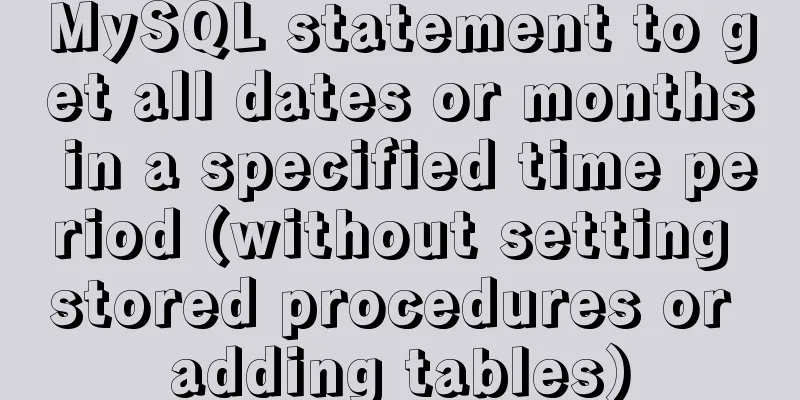MySQL statement to get all dates or months in a specified time period (without setting stored procedures or adding tables)

|
mysql gets all dates or months in a time period 1: mysql gets all months in the time period
select DATE_FORMAT(date_add('2020-01-20 00:00:00', interval row MONTH),'%Y-%m') date from
(
SELECT @row := @row + 1 as row FROM
(select 0 union all select 1 union all select 2 union all select 3 union all select 4 union all select 5 union all select 6 union all select 7 union all select 8 union all select 9) t,
(select 0 union all select 1 union all select 2 union all select 3 union all select 4 union all select 5 union all select 6 union all select 7 union all select 8 union all select 9) t2,
(SELECT @row:=-1) r
)
where DATE_FORMAT(date_add('2020-01-20 00:00:00', interval row MONTH),'%Y-%m') <= DATE_FORMAT('2020-04-02 00:00:00','%Y-%m')2: mysql gets all dates in a time period
select date_add('2020-01-20 00:00:00', interval row DAY) date from
(
SELECT @row := @row + 1 as row FROM
(select 0 union all select 1 union all select 2 union all select 3 union all select 4 union all select 5 union all select 6 union all select 7 union all select 8 union all select 9) t,
(select 0 union all select 1 union all select 2 union all select 3 union all select 4 union all select 5 union all select 6 union all select 7 union all select 8 union all select 9) t2,
(SELECT @row:=-1) r
)
where date_add('2020-01-20 00:00:00', interval row DAY) <= '2020-03-02 00:00:00'Remark: This code indicates the limit on the number of data entries. If you write two queries, the maximum number of displayed data entries is 100. If you write three queries, the maximum number of displayed data entries is 1000. And so on. You can decide according to your needs. The following is how to set the maximum number of displayed items to 10,000
I hope this helps. Newbie online looking for guidance! ! ! The following are the supplements from other netizens for your reference 1. Get all dates in a time period in MySQL without using stored procedures, temporary tables, or loops
select a.Date
from (
select curdate() - INTERVAL (aa + (10 * ba) + (100 * ca)) DAY as Date
from (select 0 as a union all select 1 union all select 2 union all select 3 union all select 4 union all select 5 union all select 6 union all select 7 union all select 8 union all select 9) as a
cross join (select 0 as a union all select 1 union all select 2 union all select 3 union all select 4 union all select 5 union all select 6 union all select 7 union all select 8 union all select 9) as b
cross join (select 0 as a union all select 1 union all select 2 union all select 3 union all select 4 union all select 5 union all select 6 union all select 7 union all select 8 union all select 9) as c
)
where a.Date between '2017-11-10' and '2017-11-15'The output is as follows
2. MySQL gets a list of all dates within two dates
select @num:=@num+1,date_format(adddate('2015-09-01', INTERVAL @num DAY),'%Y-%m-%d') as date
from btc_user,(select @num:=0) t where adddate('2015-09-01', INTERVAL @num DAY) <= date_format(curdate(),'%Y-%m-%d')
order by date;The advantage of this method is that you don't need to create a stored procedure or calendar table. The disadvantage is that you must have a table with enough data to support the number of days you want to query. 3. MySQL gets a list of all dates within a given time period (stored procedure)
DELIMITER $$
DROP PROCEDURE IF EXISTS create_calendar $$
CREATE PROCEDURE create_calendar (s_date DATE, e_date DATE)
BEGIN
-- Generate a calendar table SET @createSql = 'CREATE TABLE IF NOT EXISTS calendar_custom (
`date` date NOT NULL,
UNIQUE KEY `unique_date` (`date`) USING BTREE
)ENGINE=InnoDB DEFAULT CHARSET=utf8';
prepare stmt from @createSql;
execute stmt;
WHILE s_date <= e_date DO
INSERT IGNORE INTO calendar_custom VALUES (DATE(s_date)) ;
SET s_date = s_date + INTERVAL 1 DAY;
END WHILE ;
END$$
DELIMITER ;
-- Generate data to the calendar_custom table for all dates between 2009-01-01 and 2029-01-01 CALL create_calendar ('2009-01-01', '2029-01-01');
DELIMITER $$
DROP PROCEDURE IF EXISTS create_calendar $$
CREATE PROCEDURE create_calendar (s_date DATE, e_date DATE)
BEGIN
-- Generate a calendar table SET @createSql = 'truncate TABLE calendar_custom';
prepare stmt from @createSql;
execute stmt;
WHILE s_date <= e_date DO
INSERT IGNORE INTO calendar_custom VALUES (DATE(s_date)) ;
SET s_date = s_date + INTERVAL 1 DAY;
END WHILE ;
END$$
DELIMITER ;
-- Generate data to the calendar_custom table for all dates between 2009-01-01 and 2029-01-01 CALL create_calendar ('2009-01-02', '2009-01-07');This is the end of this article about MySQL statements for getting all dates or months in a specified time period (without setting up stored procedures or adding tables). For more information about MySQL statements for getting dates and months in a specified time period, please search previous articles on 123WORDPRESS.COM or continue to browse the following related articles. I hope you will support 123WORDPRESS.COM in the future! You may also be interested in:
|
<<: The url value of the src or css background image is the base64 encoded code
>>: Detailed method of using goaccess to analyze nginx logs
Recommend
DOCTYPE type detailed introduction
<br />We usually declare DOCTYPE in HTML in ...
How to modify the "Browse" button of the html form to upload files
Copy code The code is as follows: <!DOCTYPE HT...
Why is it not recommended to use index as key in react?
1. Compare the old virtual DOM with the new virtu...
Implementation of CSS text shadow gradually blurring effect
text-shadow Add a shadow to the text. You can add...
jQuery implements sliding tab
This article example shares the specific code of ...
WeChat applet implements the Record function
This article shares the specific code for the WeC...
CSS3 new layout: flex detailed explanation
Flex Basic Concepts Flex layout (flex is the abbr...
HTTP return code list (Chinese and English explanation)
http return code list (below is an overview) for ...
Four data type judgment methods in JS
Table of contents 1. typeof 2. instanceof 3. Cons...
Automatically install the Linux system based on cobbler
1. Install components yum install epel-rpm-macros...
Detailed introduction of Chrome developer tools-timeline
1. Overview Users expect the web applications the...
Summary of coalesce() usage tips in MySQL
Preface Recently, I accidentally discovered MySQL...
Vue2 implements provide inject to deliver responsiveness
1. Conventional writing in vue2 // The parent com...
Detailed explanation of obtaining, assigning, and registering radio values in HTML
1. Radio grouping As long as the name is the same,...
mysql-8.0.17-winx64 deployment method
1. Download mysql-8.0.17-winx64 from the official...










